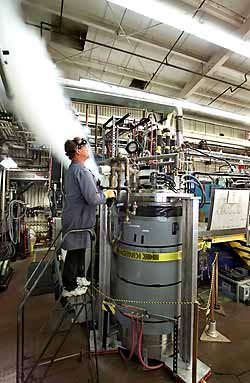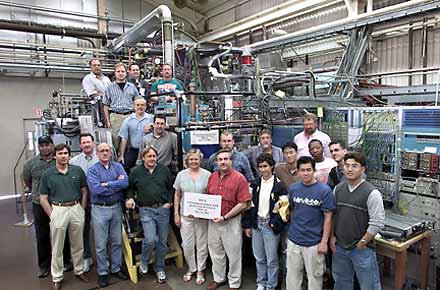|
Is there a more rewarding thrill than to break a record?
Whereas most of us must content ourselves with breaking
personal bests, earlier this month the scientists and
engineers of Berkeley Lab’s Superconducting Magnet Group
experienced the rush of shattering a world record. The
team’s newest niobium-tin dipole electromagnet reached
an unprecedented field-strength of 14.7 Tesla. This is
more than 300,000 times the strength of Earth’s magnetic
field.
 |

BERKELEY LAB'S RD-3 MAGNET
REACHED A WORLD-RECORD 14.7 TESLA FIELD STRENGTH
IN THE FINAL QUENCHING TEST
|
"Our job is to push the technology envelope as far
as we can in terms of high magnetic field strength and
that is what we have done," says Steve Gourlay, a
physicist with the Accelerator and Fusion Research Division
(AFRD) who lead the team that designed and built the new
champion.
Dubbed RD-3, the new world record-holding magnet is one
meter long and weighs several tons. It consists of three
magnetic coil modules (a double-pancake outer and single-layer
inner) which were wound from more than eight miles worth
of niobium-tin wire. The previous record field strength
for a dipole electromagnet was 13.5 Tesla. It was set
in 1997 also by a niobium-tin electromagnet designed and
built here at Berkeley Lab.
Members of the new record-holding team in addition to
Gourlay were Robert Benjegerdes, Paul Bish, Doyle Byford,
Shlomo Caspi, Daniel Dietderich, Ray Hafalia, Charles
Hannaford, Hugh Higley, Alan Jackson, Alan Lietzke, Nate
Liggins, Alfred McInturff, Jim O'Neil, Evan Palmerston,
GianLuca Sabbi, Ron Scanlan, and James Swanson.
Dipole magnets are used to bend and maintain the path
of accelerating particle beams. The higher the field strengths
of the magnets, the tighter the arc of the beam. With
stronger dipole magnets, an accelerator can push particles
to much higher relativistic energies around the same-sized
circular beam path.
That conventional electromagnets cannot attain a dipole
field strength much above 2 Tesla has meant the continuing
development of new and better superconducting alloys.
However, the use of high field-strength superconducting
electromagnets presents its own formidible technical challenge
in that superconductivity has a tendency to weaken and
disappear in the presence of a strong magnetic field.
"We’re charged with developing superconducting magnet
technology that not only yields high field strength but
is also cost effective for the next generation of accelerators,"
says Gourlay. "To achieve this, we have been working
with a niobium-tin superconductor (Nb3Sn) and emphasizing
simplicity in our design."
Today’s most powerful particle accelerators, including
the Tevatron and the Large Hadron Collider, rely on dipoles
fashioned out of a niobium-titanium alloy. This material
while offering the distinct advantage of being ductile
is limited to a field strength no greater than 10 Tesla.
The niobium-tin superconductor was believed in theory
to be capable of reaching field strengths in excess of
14 Tesla. However, until the 1997 record-setting performance
of the Superconducting Magnet Group’s D20 magnet, niobium-tin
was considered too brittle and fragile to be able to withstand
the forces that threaten to push the coil windings apart.
"These forces are enormous, about 3 million pounds
or more than the combined thrust of more than a dozen
747 planes," says Gourlay. "To withstand this
force, we needed a really good support structure design."
The design Gourlay and his colleagues employed is centered
around a "common-coil racetrack" geometry, an
idea that originated at Brookhaven National Laboratory,
in which a pair of coils shaped like an oval racetrack
are shared between two apertures to produce opposing magnetic
fields.
"A racetrack coil design offers a flat geometry
that can handle the forces and is well suited for use
in a particle accelerator," says Gourlay. "It
also offers a simplicity of construction that helps make
it cost-effective."
To overcome the brittleness factor of niobium-tin, Gourlay
and his team made their coil modules using a "wind
and react" technique. The cable was made from separate
strands of niobium and tin which were fabricated by Oxford
Superconducting Technologies. It was then wound around
an iron "pole piece" and impregnated with an
epoxy filler to make each coil module. Not until after
the cable was wound into the three coil modules were the
strands "reacted" to make the superconducting
alloy. This reaction was accomplished by heating the cable
to about 950 Kelvin (680 degrees Celsius) and baking it
at that temperature for two weeks.
To complete the magnet, the coils were encased in an
iron yoke then wrapped in a 40-millimeter-thick aluminum
shell. For the coils to become superconducting, they have
to be cooled to a temperature of about 4.2 Kelvin (-270
degrees Celsius). This starts the process whereby a magnet
is "trained" to attain its peak field strength.
A magnet will be chilled to make its coils superconducting,
then energized up in field strength until an inadvertent
warming along some part of the coils causes the magnet
to lose its superconductivity. This temporary loss of
superconductivity is called "quenching." After
quenching occurs, the magnet is re-cooled and training
resumes. The process will be repeated until the magnet
reaches the field-strength limit dictated by the properties
of its superconductor.
"This magnet trained slowly," says Gourlay.
"It took us 35 quenches to reach 14.7 Tesla at 4
Kelvin (the old record of 13.5 Tesla was achieved at 1.8
Kelvin)."
Records are made to be broken and already the Superconducting
Magnet Group is planning the design of a magnet that should
reach a field strength of 15 Tesla.
"We’re always looking forward," says Gourlay.
"After we reach 15 Tesla, we’ll aim for 16 Tesla."
Gourlay does say that in the next magnet, he and his
group will concentrate on improving the quality of their
magnetic field as well as the quantity.

MEMBERS OF THE TEAM THAT BUILT THE RECORD-SHATTERING
MAGNET POSE IN FRONT OF RD-3 IN THE LABORATORY TEST AREA.
Additional information:
|


